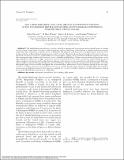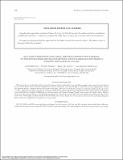| dc.contributor.author | Henault, Justis | |
| dc.contributor.author | Norris, D. Ryan | |
| dc.contributor.author | Linton, Jessica E. | |
| dc.contributor.author | Westwood, Richard | |
| dc.date.accessioned | 2023-01-23T22:06:05Z | |
| dc.date.available | 2023-01-23T22:06:05Z | |
| dc.date.issued | 2022-03-09 | |
| dc.identifier.citation | Henault, Justis, D. Ryan Norris, Jessica E. Linton, and Richard Westwood. “Egg Laying Behaviour and Larval Shelter-Construction Patterns of the endangered Mottled Duskywing (Erynnis martialis) in Canada.” The Journal of the Lepidopterists’ Society 76(1) (2022): 43-55, DOI: 10.18473/lepi.76i1.a6; addendum, 76(2) (2022): 160, DOI: 10.18473/lepi.76i2.a11. | en_US |
| dc.identifier.issn | 0024-0966 | |
| dc.identifier.uri | https://hdl.handle.net/10680/2029 | |
| dc.description.abstract | The Mottled duskywing (Erynnis martialis) butterfly is endangered, living in pine forests and oak barrens in Canada and the eastern United States of America. While host plants and larval behaviour is documented in Mottled duskywing’s eastern range, these life components are poorly known in Manitoba. We observed adult behaviour, host plant species used and larval foraging to better understand these biological aspects of E. martialis. We observed eggs laid exclusively on Ceanothus herbaceus, and larvae consuming C. herbaceus in leaf shelters near the periphery of plants. Early instar larvae tied leaves together with cells of silk creating partly open shelters while later instar larvae completely sealed shelters. Shelters constructed out of young leaves at the edge of plants are likely easier to digest. Later-instar larvae may nocturnally harvest food to consume in shelters during the day to reduce predation risk. Larvae were found in clearings adjacent to Pinus banksiana dominated forests, with these openings likely providing suitable microhabitats for egg development and larval feeding. We observed newly emerged adults during weeks 1 to 5 of the flight period; eggs, larvae and adults overlapped. We recommend direct observations of larval foraging—during the day and night, as well as transitions into and out of diapause—to more accurately describe their behaviour and physiology. We started to characterise microhabitats, however further research is needed. Our research may help to guide critical habitat designations, leading to successful Mottled duskywing recovery in Manitoba. | en_US |
| dc.description.sponsorship | "Funding was provided by the Canadian Wildlife Service (Environment and Climate Change Canada, Government of Canada) and an Alliance Grant from the Natural Sciences and Engineering Research Council of Canada. JH thanks the support for publication fees by the University of Winnipeg Graduate Student Travel / Publication Grant." | en_US |
| dc.description.uri | https://bioone.org/journals/the-journal-of-the-lepidopterists-society/volume-76/issue-1/lepi.76i1.a6/Egg-Laying-Behaviour-and-Larval-Shelter-Construction-Patterns-of-the/10.18473/lepi.76i1.a6.short | en_US |
| dc.language.iso | en | en_US |
| dc.publisher | The Lepidopterists' Society | en_US |
| dc.rights | info:eu-repo/semantics/openAccess | en_US |
| dc.subject | Endangered | en_US |
| dc.subject | Microhabitat | en_US |
| dc.subject | Larval feeding | en_US |
| dc.subject | Flight period | en_US |
| dc.title | Egg Laying Behaviour and Larval Shelter-Construction Patterns of the endangered Mottled Duskywing (Erynnis martialis) in Canada | en_US |
| dc.type | Animation | en_US |
| dc.identifier.doi | 10.18473/lepi.76i1.a6 | en_US |


